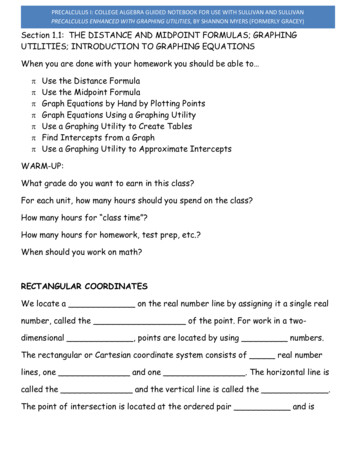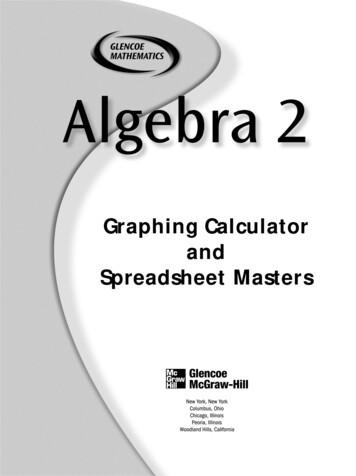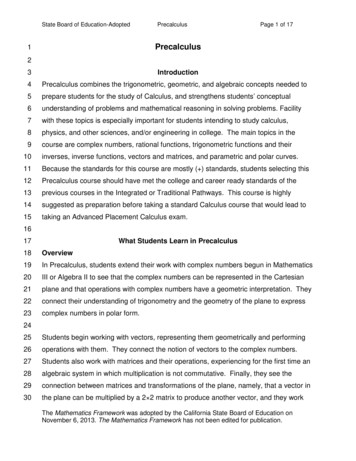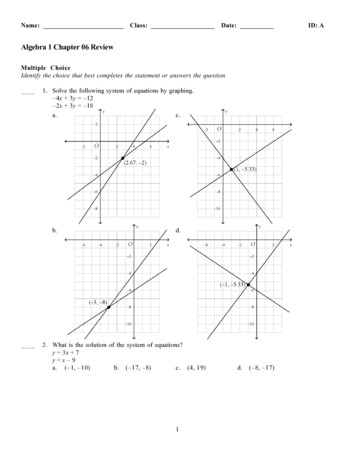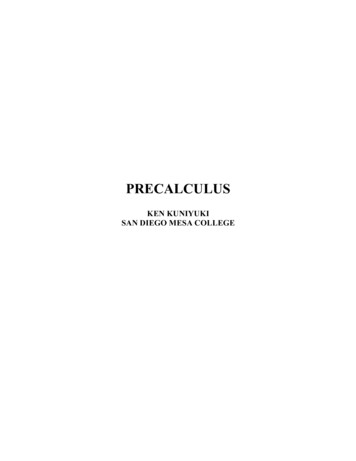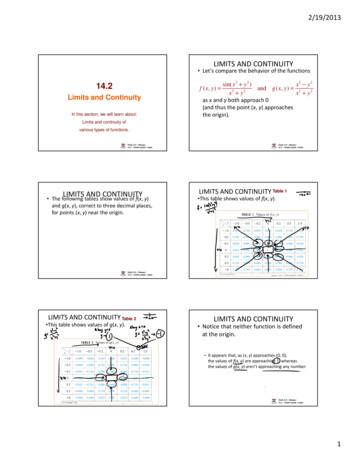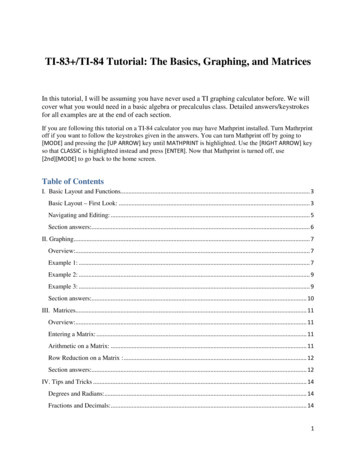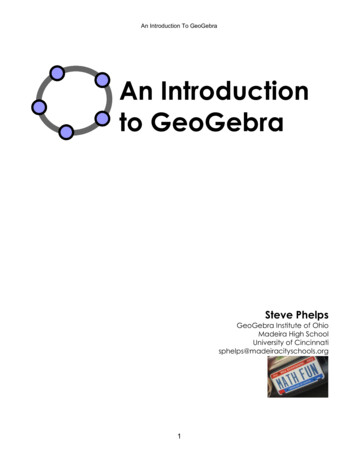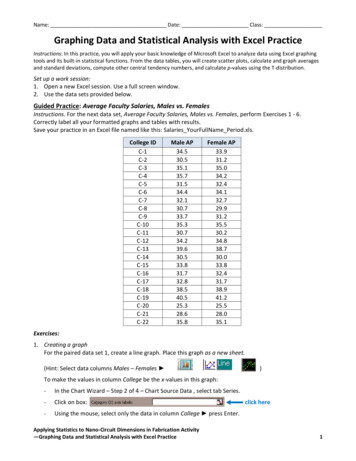
Transcription
Correlation ofPrecalculus with Limits: A Graphing Approach,with CalcChat and CalcView , 8/E,by Ron Larson/ Paul Battaglia, 2020,ISBN: 9781337904285toFloridaB.E.S.T. Standards for MathematicsPre-Calculus Honors 1202340
Correlation to the Florida B.E.S.T Standards for Mathematics, Pre-Calculus Honors 1202340Precalculus with Limits: A Graphing Approach, with CalcChat and CalcView , 8/E,by Ron Larson/ Paul Battaglia, 2020,ISBN: 9781337904285National Geographic Learning CengageBID ID:SUBMISSION TITLE:GRADE LEVEL:COURSE TITLE:COURSE CODE:ISBN:PUBLISHER:448Precalculus with Limits: A Graphing Approach, with CalcChat and CalcView , 8/E9-12Pre-Calculus Honors12023409781337904285Cengage Learning, Inc.COURSE STANDARDSWHERE ADDRESSEDPre-Calculus HonorsIn Precalculus Honors, instructional time will emphasize six areas: (1) extending righttriangle trigonometry to unit circle trigonometry and trigonometric functions; (2)extending understanding of functions to trigonometric; (3) developing understanding ofconic sections; (4) representing and performing operations with complex numbers andvectors in the coordinate plane; (5) extending understanding of relations in the planeusing parametric representations, including polar coordinates and (6) analyzingarithmetic and geometric sequences and series.All clarifications stated, whether general or specific to Precalculus Honors, areexpectations for instruction of that benchmark.Curricular content for all subjects must integrate critical-thinking, problem-solving, andworkforce-literacy skills; communication, reading, and writing skills; mathematics skills;collaboration skills; contextual and applied-learning skills; technology-literacy skills;information and media-literacy skills; and civic-engagement skills.MA.912.AR.5.7:Solve and graph mathematical and real-world problems that aremodeled with exponential functions. Interpret key features anddetermine constraints in terms of the context.Clarifications:Clarification 1: Key features are limited to domain; range;intercepts; intervals where the function is increasing, decreasing,positive or negative; constant percent rate of change; endbehavior and asymptotes.Clarification 2: Instruction includes representing the domain,range and constraints with inequality notation, interval notationor set-builder notation.Precalculus with Limits: A Graphing Approach, with CalcChat and CalcView , 8/E –FL – Pre-Calculus Honors 1202340Page 2 of 20Section 3.1 (pp. 182-193),Section 3.5 (pp. 223-228, 230-234),Section 3.6 (pp. 238, 240-243)05-2021/ www.ngl.cengage.com/correlations
Correlation to the Florida B.E.S.T Standards for Mathematics, Pre-Calculus Honors 1202340Precalculus with Limits: A Graphing Approach, with CalcChat and CalcView , 8/E,by Ron Larson/ Paul Battaglia, 2020,ISBN: 9781337904285National Geographic Learning CengageCOURSE :Clarification 3: Instruction includes understanding that when thelogarithm of the dependent variable is taken and graphed, theexponential function will be transformed into a linear function.Clarification 4: Within the Mathematics for Data and FinancialLiteracy course, problem types focus on money and business.Solve and graph mathematical and real-world problems that aremodeled with logarithmic functions. Interpret key features anddetermine constraints in terms of the context.Clarifications:Clarification 1: Key features are limited to domain; range;intercepts; intervals where the function is increasing, decreasing,positive or negative; end behavior; and asymptotes.Clarification 2: Instruction includes representing the domain,range and constraints with inequality notation, interval notationor set-builder notation.Explain and apply theorems for polynomials to solvemathematical and real-world problems.Clarifications:Clarification 1: Theorems include the Factor Theorem and theFundamental Theorem of Algebra.Given a table, equation or written description of a polynomialfunction of degree 3 or higher, graph that function and determineits key features.Clarifications:Clarification 1: Key features are limited to domain; range;intercepts; intervals where the function is increasing, decreasing,positive or negative; relative maximums and minimums;symmetry; and end behavior.Clarification 2: Instruction includes representing the domain andrange with inequality notation, interval notation or set-buildernotation.Precalculus with Limits: A Graphing Approach, with CalcChat and CalcView , 8/E –FL – Pre-Calculus Honors 1202340Page 3 of 20WHERE ADDRESSEDSection 3.2 (pp. 194-205),Section 3.5 (pp. 228-229, 230-234),Section 3.6 (pp. 239, 240-243)Section 2.2 (pp. 108-112),Section 2.3 (pp. 117, 125 #37-58),Section 2.5 (pp. 135-141)Section 2.2 (pp. 100-112)05-2021/ www.ngl.cengage.com/correlations
Correlation to the Florida B.E.S.T Standards for Mathematics, Pre-Calculus Honors 1202340Precalculus with Limits: A Graphing Approach, with CalcChat and CalcView , 8/E,by Ron Larson/ Paul Battaglia, 2020,ISBN: 9781337904285National Geographic Learning CengageCOURSE STANDARDSWHERE ADDRESSEDMA.912.AR.6.6:Solve and graph mathematical and real-world problems that aremodeled with polynomial functions of degree 3 or higher.Interpret key features and determine constraints in terms of thecontext.Clarifications:Clarification 1: Key features are limited to domain; range;intercepts; intervals where the function is increasing, decreasing,positive or negative; relative maximums and minimums;symmetry; and end behavior.Clarification 2: Instruction includes representing the domain,range and constraints with inequality notation, interval notationor set-builder notation.Section 2.2 (pp. 100-112),Section 2.3 (pp. 113-127),Section 2.5 (pp. 135-141)MA.912.AR.7.4:Solve and graph mathematical and real-world problems that aremodeled with radical functions. Interpret key features anddetermine constraints in terms of the context.Clarifications:Clarification 1: Key features are limited to domain; range;intercepts; intervals where the function is increasing, decreasing,positive or negative; end behavior; and relative maximums andminimums.Clarification 2: Instruction includes representing the domain,range and constraints with inequality notation, interval notationor set-builder notation.Section 1.2 (pp. 20, 25-26 #21, 22, 35, 36, 61, 62, 67, 68, 71),Section 1.3 (pp. 30, 37-38 #13, 14, 37, 38, 47, 48, 75, 76, 91, 92)Precalculus with Limits: A Graphing Approach, with CalcChat and CalcView , 8/E –FL – Pre-Calculus Honors 1202340Page 4 of 2005-2021/ www.ngl.cengage.com/correlations
Correlation to the Florida B.E.S.T Standards for Mathematics, Pre-Calculus Honors 1202340Precalculus with Limits: A Graphing Approach, with CalcChat and CalcView , 8/E,by Ron Larson/ Paul Battaglia, 2020,ISBN: 9781337904285National Geographic Learning CengageCOURSE STANDARDSMA.912.AR.8.3:Solve and graph mathematical and real-world problems that aremodeled with rational functions. Interpret key features anddetermine constraints in terms of the context.Clarifications:Clarification 1: Key features are limited to domain; range;intercepts; intervals where the function is increasing, decreasing,positive or negative; end behavior; and asymptotes.WHERE ADDRESSEDSection 2.6 (pp. 142-150),Section 2.7 (pp. 151-160)Clarification 2: Instruction includes representing the domain,range and constraints with inequality notation, interval notationor set-builder .1:MA.912.AR.10.2:Clarification 3: Instruction includes using rational functions torepresent inverse proportional relationships.Clarification 4: Within the Algebra 2 course, numerators anddenominators are limited to linear and quadratic expressions.Given a mathematical or real-world context, solve a systemconsisting of two-variable linear or non-linear equationsalgebraically or graphically.Clarifications:Clarification 1: Within the Algebra 2 course, non-linear equationsare limited to quadratic equations.Solve and graph mathematical and real-world problems that aremodeled with piecewise functions. Interpret key features anddetermine constraints in terms of the context.Clarifications:Clarification 1: Key features are limited to domain, range,intercepts, asymptotes and end behavior.Clarification 2: Instruction includes representing the domain,range and constraints with inequality notation, interval notationor set-builder notation.Given a mathematical or real-world context, write and solveproblems involving arithmetic sequences.Given a mathematical or real-world context, write and solveproblems involving geometric sequences.Precalculus with Limits: A Graphing Approach, with CalcChat and CalcView , 8/E –FL – Pre-Calculus Honors 1202340Page 5 of 20Section 7.1 (pp. 478-487),Section 7.2 (pp. 488-496),Section 7.3 (pp. 497-511)Section 1.2 (pp. 19, 22, 25 #42-46, 27 #80-81),Section 1.3 (pp. 34,38 #61-66),Section 1.6 (pp. 68 #55-56),Section 1.7 (p. 68 #26)Section 8.2 (pp. 591-598)Section 8.3 (pp. 599-608)05-2021/ www.ngl.cengage.com/correlations
Correlation to the Florida B.E.S.T Standards for Mathematics, Pre-Calculus Honors 1202340Precalculus with Limits: A Graphing Approach, with CalcChat and CalcView , 8/E,by Ron Larson/ Paul Battaglia, 2020,ISBN: 9781337904285National Geographic Learning CengageCOURSE STANDARDSWHERE ADDRESSEDMA.912.AR.10.3:Recognize and apply the formula for the sum of a finitearithmetic series to solve mathematical and real-world problems.Section 8.2 (pp. 594-595, 597-598)MA.912.AR.10.4:Recognize and apply the formula for the sum of a finite or aninfinite geometric series to solve mathematical and real-worldproblems.Given a mathematical or real-world context, write a sequenceusing function notation, defined explicitly or recursively, torepresent relationships between quantities from a writtendescription.Section 8.3 (pp. 602-604, rite an algebraic expression that represents the differencequotient of a function. Calculate the numerical value of thedifference quotient at a given pair of points.Clarifications:Clarification 1: Instruction focuses on making connectionsbetween difference quotients and slopes of lines.Compare key features of two functions each representedalgebraically, graphically, in tables or written descriptions.Clarifications:Clarification 1: Key features include domain; range; intercepts;intervals where the function is increasing, decreasing, positive ornegative; end behavior and asymptotes.Section 8.1 (p. 580)Additional opportunities to address this benchmark occurs in:Section 8.2 (pp. 591-598),Section 8.3 (pp. 599-608)Section 1.2 (pp. 21, 28 #85-88),Section 5.4 (p. 382 Example 7),Section 8.4 (p. 615 #83-86),Section 11.2 (p. 776),Section 11.3 (pp. 784-785)The opportunity to address this standard exists. For example, see:Section 1.2 (pp. 16-29),Section 1.4 (pp. 41-49),Section 2.1 (pp. 90-99),Section 2.2 (pp. 100-112),Section 2.6 (pp. 142-150),Section 2.7 (pp. 151-160),Section 3.1 (pp. 182-193),Section 3.2 (pp. 194-204)Section 1.5 (pp. 50-51, 56-59)MA.912.F.3.3:Solve mathematical and real-world problems involving functionsthat have been combined using arithmetic operations.MA.912.F.3.4:Represent the composition of two functions algebraically or in atable. Determine the domain and range of the compositefunction.Section 1.5 (pp. 52-59)MA.912.F.3.5:Solve mathematical and real-world problems involvingcomposite functions.Section 1.5 (pp. 52-59)Precalculus with Limits: A Graphing Approach, with CalcChat and CalcView , 8/E –FL – Pre-Calculus Honors 1202340Page 6 of 2005-2021/ www.ngl.cengage.com/correlations
Correlation to the Florida B.E.S.T Standards for Mathematics, Pre-Calculus Honors 1202340Precalculus with Limits: A Graphing Approach, with CalcChat and CalcView , 8/E,by Ron Larson/ Paul Battaglia, 2020,ISBN: 9781337904285National Geographic Learning CengageCOURSE STANDARDSMA.912.F.3.7:WHERE ADDRESSEDRepresent the inverse of a function algebraically, graphically orin a table. Use composition of functions to verify that onefunction is the inverse of the other.Clarifications:Clarification 1: Instruction includes the understanding that alogarithmic function is the inverse of an exponential function.Produce an invertible function from a non-invertible function byrestricting the domain.Section 1.6 (pp. 60-70),Section 4.7 (pp. 317-327)MA.912.F.3.9:Solve mathematical and real-world problems involving inversefunctions.Section 1.6 (pp. 60-70),Section 4.7 (pp. 317-327)MA.912.GR.7.1:Given a conic section, describe how it can result from the slicingof two cones.Section 9.1 (p. 646)MA.912.GR.7.2:Given a mathematical or real-world context, derive and createthe equation of a circle using key features.Clarifications:Clarification 1: Instruction includes using the PythagoreanTheorem and completing the square.Clarification 2: Within the Geometry course, key features arelimited to the radius, diameter and the center.Graph and solve mathematical and real-world problems that aremodeled with an equation of a circle. Determine and interpretkey features in terms of the context.Clarifications:Clarification 1: Key features are limited to domain, range,eccentricity, center and radius.Clarification 2: Instruction includes representing the domain andrange with inequality notation, interval notation or set-buildernotation.Clarification 3: Within the Geometry course, notations for domainand range are limited to inequality and set-builder.Given a mathematical or real-world context, derive and createthe equation of a parabola using key features.Section 9.1 (pp. 647-648, 653 calculus with Limits: A Graphing Approach, with CalcChat and CalcView , 8/E –FL – Pre-Calculus Honors 1202340Page 7 of 20Section 1.6 (pp. 66, 70 #137),Section 4.7 (pp. 317, 319, 327 #117-119)Section 9.1 (pp. 647-648, 653 #1-38)Section 9.1 (pp. 649-655)05-2021/ www.ngl.cengage.com/correlations
Correlation to the Florida B.E.S.T Standards for Mathematics, Pre-Calculus Honors 1202340Precalculus with Limits: A Graphing Approach, with CalcChat and CalcView , 8/E,by Ron Larson/ Paul Battaglia, 2020,ISBN: 9781337904285National Geographic Learning CengageCOURSE :MA.912.GR.7.8:MA.912.GR.7.9:MA.912.NSO.2.2:WHERE ADDRESSEDGraph and solve mathematical and real-world problems that aremodeled with an equation of a parabola. Determine and interpretkey features in terms of the context.Clarifications:Clarification 1: Key features are limited to domain, range,eccentricity, intercepts, focus, focal width (latus rectum), vertexand directrix.Clarification 2: Instruction includes representing the domain andrange with inequality notation, interval notation or set-buildernotation.Given a mathematical or real-world context, derive and createthe equation of an ellipse using key features.Section 9.1 (pp. 649-655)Graph and solve mathematical and real-world problems that aremodeled with an equation of an ellipse. Determine and interpretkey features in terms of the context.Clarifications:Clarification 1: Key features are limited to domain, range,eccentricity, center, foci, major axis, minor axis and vertices.Clarification 2: Instruction includes representing the domain andrange with inequality notation, interval notation or set-buildernotation.Given a mathematical or real-world context, derive and createthe equation of a hyperbola using key features.Graph and solve mathematical and real-world problems that aremodeled with an equation of a hyperbola. Determine andinterpret key features in terms of the context.Clarifications:Clarification 1: Key features are limited to domain, range,eccentricity, center, vertices, foci, transverse axis, conjugateaxis, asymptotes and directrices.Clarification 2: Instruction includes representing the domain andrange with inequality notation, interval notation or set-buildernotation.Represent addition, subtraction, multiplication and conjugation ofcomplex numbers geometrically on the complex plane.Section 9.2 (pp. 657-665)Precalculus with Limits: A Graphing Approach, with CalcChat and CalcView , 8/E –FL – Pre-Calculus Honors 1202340Page 8 of 20Section 9.2 (pp. 657-665)Section 9.3 (pp. 666-678)Section 9.3 (pp. 666-678)Section 6.5 (pp. 446-447, 449 #25-36),Section 6.6 (pp. 445, 452 #5-20),05-2021/ www.ngl.cengage.com/correlations
Correlation to the Florida B.E.S.T Standards for Mathematics, Pre-Calculus Honors 1202340Precalculus with Limits: A Graphing Approach, with CalcChat and CalcView , 8/E,by Ron Larson/ Paul Battaglia, 2020,ISBN: 9781337904285National Geographic Learning CengageCOURSE 3:MA.912.T.1.4:MA.912.T.1.5:WHERE ADDRESSEDCalculate the distance and midpoint between two numbers onthe complex coordinate plane.Solve mathematical and real-world problems involving complexnumbers represented algebraically or on the coordinate plane.Represent complex numbers on the complex plane inrectangular and polar forms.Clarifications:Clarification 1: Instruction includes explaining why therectangular and polar forms of a given complex numbersrepresent the same number.Rewrite complex numbers to trigonometric form. Multiplycomplex numbers in trigonometric form.Apply appropriate notation and symbols to represent vectors inthe plane as directed line segments. Determine the magnitudeand direction of a vector in component form.Represent vectors in component form, linear form ortrigonometric form. Rewrite vectors from one form to another.Solve mathematical and real-world problems involving velocityand other quantities that can be represented by vectors.Solve mathematical and real-world problems involving vectors intwo dimensions using the dot product and vector projections.Multiply a vector by a scalar algebraically or graphically.Section 6.5 (pp. 448, 443 #35-38, 450 #41-48)Compute the magnitude and direction of a vector scalar multiple.Add and subtract vectors algebraically or graphically.Given the magnitude and direction of two or more vectors,determine the magnitude and direction of their sum.Apply the Law of Sines and the Law of Cosines to solvemathematical and real-world problems involving triangles.Solve mathematical problems involving finding the area of atriangle given two sides and the included angle.Clarifications:Clarification 1: Problems include right triangles, heights inside ofa triangle and heights outside of a triangle.Prove Pythagorean Identities. Apply Pythagorean Identities tocalculate trigonometric ratios and to solve problems.Section 6.3 (pp. 425, 432 #49-52)Section 6.3 (pp. 424-425, 427, 432 #35-44)Section 6.3 (pp. 424-425, 427, 432 #35-44)Precalculus with Limits: A Graphing Approach, with CalcChat and CalcView , 8/E –FL – Pre-Calculus Honors 1202340Page 9 of 20Section 2.4 (pp. 128-134),Section 6.5 (pp. 445-450)Section 6.6 (pp. 451-452, 459 #7-49),Section 9.5 (pp. 687-692)Section 6.6 (pp. 451-461)Section 6.3 (pp. 422-423, 431 #23-30)Section 6.3 (pp. 423, 427-428, 431 #23-30, 432 #67-70, 83-90)Section 6.3 (pp. 429-430, 433 #102-105)Section 6.4 (pp. 436-444)Section 6.3 (pp. 424-425, 431 #32, 34, 432 #71-76)Section 6.1 (pp. 406-414),Section 6.2 (pp. 415-421)Section 6.1 (pp. 410-411, 412 #35-40, 414 #53, 55)Section 5.1 (pp. 352-358),Section 5.2 (pp. 359-366)05-2021/ www.ngl.cengage.com/correlations
Correlation to the Florida B.E.S.T Standards for Mathematics, Pre-Calculus Honors 1202340Precalculus with Limits: A Graphing Approach, with CalcChat and CalcView , 8/E,by Ron Larson/ Paul Battaglia, 2020,ISBN: 9781337904285National Geographic Learning CengageCOURSE STANDARDSWHERE ADDRESSEDMA.912.T.1.6:Prove the Double-Angle, Half-Angle, Angle Sum and Differenceformulas for sine, cosine, and tangent. Apply these formulas tosolve problems.Section 5.4 (pp. 379-385),Section 5.5 (pp. 386-395)MA.912.T.1.7:Simplify expressions using trigonometric identities.Clarifications:Clarification 1: Identities are limited to Double-Angle, Half-Angle,Angle Sum and Difference, Pythagorean Identities, SumIdentities and Product Identities.Solve mathematical and real-world problems involving onevariable trigonometric ratios.Section 5.1 (pp. 352-358),Section 5.2 (pp. 359-366),Section 5.4 (pp. 379-385),Section 5.5 (pp. 386-395)Given any positive or negative angle measure in degrees orradians, identify its corresponding angle measure between 0 and 360 or between 0 and 2π. Convert between degrees andradians.Define the six basic trigonometric functions for all real numbersby identifying corresponding angle measures and using righttriangles drawn in the unit circle.Section 4.1 (pp. 256-260, 263-266)MA.912.T.2.3:Determine the values of the six basic trigonometric functions for𝜋 𝜋𝜋0, 6 , 3 and, 4 and their multiples using special triangles.Section 4.3 (pp. 275-285)MA.912.T.2.4:Use the unit circle to express the values of sine, cosine andtangent for 𝜋 𝑥, 𝜋 𝑥, and 2𝜋 𝑥 in terms of their values for 𝑥,where 𝑥 is any real number.Section 4.2 (pp. 267-274)MA.912.T.2.5:Given angles measured in radians or degrees, calculate thevalues of the six basic trigonometric functions using the unitcircle, trigonometric identities or technology.Given a mathematical or real-world context, choose sine, cosineor tangent trigonometric functions to model periodic phenomenawith specified amplitude, frequency, horizontal shift and midline.Section 4.2 (pp. 267-274),Section 4.3 (pp. 275-285),Section 4.4 (pp. 286-294)Section 4.5 (pp. 294-305),Section 4.6 (pp. 306-316),Section 4.8 (pp. 912.T.3.1:Precalculus with Limits: A Graphing Approach, with CalcChat and CalcView , 8/E –FL – Pre-Calculus Honors 1202340Page 10 of 20Section 4.3 (pp. 275-285),Section 4.4 (pp. 286-293),Section 4.8 (pp. 328-339)Section 4.2 (pp. 267-274),Section 4.3 (pp. 275-285)05-2021/ www.ngl.cengage.com/correlations
Correlation to the Florida B.E.S.T Standards for Mathematics, Pre-Calculus Honors 1202340Precalculus with Limits: A Graphing Approach, with CalcChat and CalcView , 8/E,by Ron Larson/ Paul Battaglia, 2020,ISBN: 9781337904285National Geographic Learning CengageCOURSE Given a table, equation or written description of a trigonometricfunction, graph that function and determine key features.Clarifications:Clarification 1: Key features are limited to domain; range;intercepts; intervals where the function is increasing, decreasing,positive or negative; relative maximums and minimums;symmetry; end behavior; periodicity; midline; amplitude; shift(s)and asymptotes.Clarification 2: Instruction includes representing the domain andrange with inequality notation, interval notation or set-buildernotation.Solve and graph mathematical and real-world problems that aremodeled with trigonometric functions. Interpret key features anddetermine constraints in terms of the context.Clarifications:Clarification 1: Key features are limited to domain; range;intercepts; intervals where the function is increasing, decreasing,positive or negative; relative maximums and minimums;symmetry; end behavior; periodicity; midline; amplitude; shift(s)and asymptotes.Clarification 2: Instruction includes representing the domain,range and constraints with inequality notation, interval notationor set-builder notation.Clarification 3: Instruction includes using technology whenappropriate.Define and plot polar coordinates. Convert between polarcoordinates and rectangular coordinates with and without theuse of technology.Represent equations given in rectangular coordinates in terms ofpolar coordinates. Represent equations given in polarcoordinates in terms of rectangular coordinates.Graph equations in the polar coordinate plane with and withoutthe use of graphing technology.Identify and graph special polar equations, including circles,cardioids, limacons, rose curves and lemniscates.Sketch the graph of a curve in the plane representedparametrically, indicating the direction of motion.Precalculus with Limits: A Graphing Approach, with CalcChat and CalcView , 8/E –FL – Pre-Calculus Honors 1202340Page 11 of 20WHERE ADDRESSEDSection 4.5 (pp. 294-305),Section 4.6 (pp. 306-316),Section 4.7 (pp. 318, 321, 324 #18-20)Section 4.5 (pp. 294-305),Section 4.6 (pp. 306-316),Section 4.7 (pp. 317-327),Section 4.8 (pp. 328-339)Section 9.5 (pp. 687-692)Section 9.5 (pp. 690, 691 #39-56, 692 #57-78)Section 9.6 (pp. 693-700)Section 9.6 (pp. 697-698, 699 #1-14, 700 #65-66, 70)Section 9.4 (pp. 679-686)05-2021/ www.ngl.cengage.com/correlations
Correlation to the Florida B.E.S.T Standards for Mathematics, Pre-Calculus Honors 1202340Precalculus with Limits: A Graphing Approach, with CalcChat and CalcView , 8/E,by Ron Larson/ Paul Battaglia, 2020,ISBN: 9781337904285National Geographic Learning CengageCOURSE STANDARDSWHERE ADDRESSEDMA.912.T.4.6:Convert from a parametric representation of a plane curve to arectangular equation, and convert from a rectangular equation toa parametric representation of a plane curve.Section 9.4 (pp. 679-686)MA.912.T.4.7:Apply parametric equations to model applications involvingmotion in the plane.Section 9.4 (p. 686 #63-64)MA.K12.MTR.1.1:Mathematicians who participate in effortful learning bothindividually and with others: Analyze the problem in a way that makes sense giventhe task. Ask questions that will help with solving the task. Build perseverance by modifying methods as neededwhile solving a challenging task. Stay engaged and maintain a positive mindset whenworking to solve tasks. Help and support each other when attempting a newmethod or approach.Clarifications:Teachers who encourage students to participate actively ineffortful learning both individually and with others: Cultivate a community of growth mindset learners. Foster perseverance in students by choosing tasks thatare challenging. Develop students’ ability to analyze and problem solve.Recognize students’ effort when solving challenging problems.This standard is addressed throughout. For example, see:Section 1.2 (pp. 16-28),Section 1.5 (pp. 50-59),Section 2.6 (pp. 142-150),Section 3.1 (pp. 182-193),Section 3.2 (pp. 194-204),Section 4.4 (pp. 286-293),Section 4.5 (pp. 294-305),Section 6.4 (pp. 436-444),Section 7.2 (pp. 488-496),Section 7.7 (pp. 550-556),Section 8.1 (pp. 580-590),Section 8.3 (pp. 590-608),Section 9.2 (pp. 657-665),Section 9.4 (pp. 679-686),Section 10.3 (pp. 736-742)Precalculus with Limits: A Graphing Approach, with CalcChat and CalcView , 8/E –FL – Pre-Calculus Honors 1202340Page 12 of 2005-2021/ www.ngl.cengage.com/correlations
Correlation to the Florida B.E.S.T Standards for Mathematics, Pre-Calculus Honors 1202340Precalculus with Limits: A Graphing Approach, with CalcChat and CalcView , 8/E,by Ron Larson/ Paul Battaglia, 2020,ISBN: 9781337904285National Geographic Learning CengageCOURSE STANDARDSMA.K12.MTR.2.1:Demonstrate understanding by representing problems in multipleways.Mathematicians who demonstrate understanding byrepresenting problems in multiple ways: Build understanding through modeling and usingmanipulatives. Represent solutions to problems in multiple ways usingobjects, drawings, tables, graphs and equations. Progress from modeling problems with objects anddrawings to using algorithms and equations. Express connections between concepts andrepresentations. Choose a representation based on the given context orpurpose.Clarifications:Teachers who encourage students to demonstrateunderstanding by representing problems in multiple ways: Help students make connections between concepts andrepresentations. Provide opportunities for students to use manipulativeswhen investigating concepts. Guide students from concrete to pictorial to abstractrepresentations as understanding progresses.Show students that various representations can have differentpurposes and can be useful in different situations.Precalculus with Limits: A Graphing Approach, with CalcChat and CalcView , 8/E –FL – Pre-Calculus Honors 1202340Page 13 of 20WHERE ADDRESSEDThis standard is addressed throughout. For example, see:Section 1.3 (pp. 29-40),Section 2.1 (pp. 90-99),Section 3.5 (pp. 223-234),Section 4.8 (pp.328-339),Section 6.3 (pp. 422-435),Section 6.5 (pp.445-450),Section 7.1 (pp. 478-487),Section 9.5 (pp. 687-692),Section 9.6 (pp. 693-700),Section 10.1 (pp. 722-728)05-2021/ www.ngl.cengage.com/correlations
Correlation to the Florida B.E.S.T Standards for Mathematics, Pre-Calculus Honors 1202340Precalculus with Limits: A Graphing Approach, with CalcChat and CalcView , 8/E,by Ron Larson/ Paul Battaglia, 2020,ISBN: 9781337904285National Geographic Learning CengageCOURSE STANDARDSMA.K12.MTR.3.1:Complete tasks with mathematical fluency.Mathematicians who complete tasks with mathematical fluency: Select efficient and appropriate methods for solvingproblems within the given context. Maintain flexibility and accuracy while performingprocedures and mental calculations. Complete tasks accurately and with confidence. Adapt procedures to apply them to a new context. Use feedback to improve efficiency when performingcalculations.Clarifications:Teachers who encourage students to complete tasks withmathematical fluency: Provide students with the flexibility to solve problems byselecting a procedure that allows them to solveefficiently and accurately. Offer multiple opportunities for students to practiceefficient and generalizable methods.Provide opportunities for students to reflect on the method theyused and determine if a more efficient method could have beenused.Precalculus with Limits: A Graphing Approach, with CalcChat and CalcView , 8/E –FL – P
Correlation of Precalculus with Limits: A Graphing Approach, with CalcChat and CalcView , 8/E, by Ron Larson/ Paul Battaglia, 2020, ISBN: 9781337904285 to Florida
